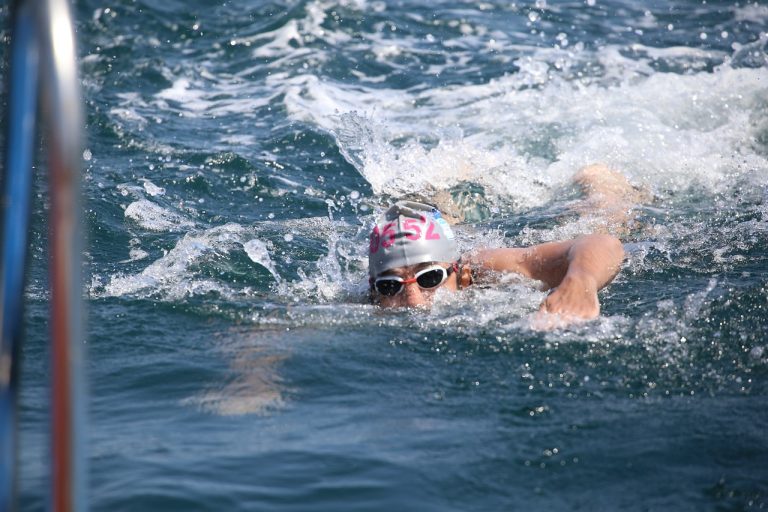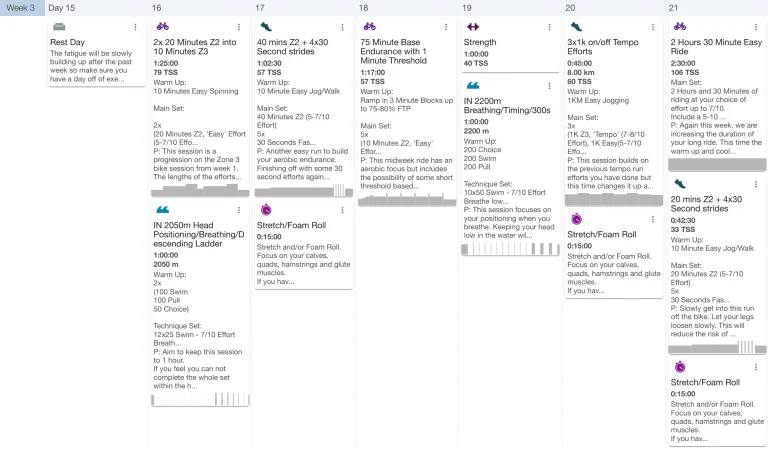Key Points:
- Define Your Goal: Before you start, know whether you’re swimming for fitness, weight loss, or training for a specific event like a triathlon, as this will shape your workout’s content.
- Follow a Proven Structure: A well-planned session should include a Warm-Up (10%), Technique Set (20-25%), an optional Pre-Main Set (10-15%), the Main Set (50-60%), and a Cool-Down (5-15%). This structure ensures you improve both technique and stamina without feeling overwhelmed.
- Focus on One Technique at a Time: During the technique set, concentrate on a single aspect of your form, such as head position or breathing, to ensure you master it effectively.
- Choose the Right Technique Focus: If your pace is slower than 1:50 per 100m, focus on improving your body position. If you’re faster, concentrate on propulsion.
- Tailor Intensity to Your Goals: For general fitness, vary the intensity of your main sets to stay motivated. If training for an event, focus your main sets around your target race pace.
- Consistency is Key: Using this structured approach consistently will lead to long-term improvements in your swimming performance, regardless of your initial skill level.
Planning an exciting swim session that keeps you motivated while improving your technique and stamina can be challenging, especially if you’re new to swimming or have been following the same routine for a while. In this guide, I’ll share how I plan a swim workout to help athletes of all levels enhance their swimming.

Define Your Swimming Goals
While having a great session structure is essential for a good swim workout, it’s important to define your goals before creating your own swim sessions. The basic structure I use works for fitness and weight loss swimmers, as well as competitive pool swimmers, open water swimmers, and triathletes. The structure remains the same, but the content can vary significantly. I will discuss the content later on, but first, I will discuss the basic structure.
Structuring A Swim Session
Improving everything at once is difficult, so it’s essential to plan a structure that allows you to develop without feeling overwhelmed. I typically focus on both technique and stamina or speed in my sessions. Below is the basic structure I use to plan a swim workout:
- Warm-Up: Around 10% of the session length. The warm-up prepares your body and should be tailored to your goals and the intensity of the workout.
- Technique Set: Around 20-25% of the session. This is where you can focus on improving your form without worrying about speed or time.
- Pre-Main Set (Optional): 10-15% of the session. For more intense or longer workouts, I add a pre-main set to gradually raise the intensity and prepare the body for the effort ahead.
- Main Set: 50-60% of the session. This is where you focus on improving fitness or a specific aspect of swimming while maintaining good technique.
- Cool-Down: 5-15% of the session. A proper cool-down helps you recover faster and adapt more quickly to the work you’ve done.

Beginner and Advanced Swimming Workout Examples
Warm-Up
Beginner:
100m Your Choice
200m Front Crawl Swim All at 4-5/10 effort
Advanced:
200m Your Choice
200m Front Crawl Swim
200m Front Crawl Pull
All at 4-5/10 effort
Explanation: This warm-up is simple and continuous, designed to gradually raise your heart rate without over stressing your muscles too quickly. By keeping it at a moderate intensity, you prevent burnout and allow yourself to relax in the water, which is especially important for easing into a productive workout.
Technique Set
Beginner: 6x50m Front Crawl – 6/10 Effort with 30 seconds rest between each 50m
Advanced: 12x50m Front Crawl – 6/10 Effort with 20 seconds rest between each 50m
Focus: Keep your head low, ensuring one ear and goggle remain in the water while breathing.
Explanation: The technique set uses short intervals with slightly higher intensity than the warm-up. These intervals prevent fatigue from setting in too early, allowing you to maintain focus on improving technique without losing form. Concentrating on a single technique point at a time ensures you can master each element before moving on to the next. Focusing on one thing at a time is key—if you try to think about too many aspects, everything else will suffer.
Main Set
Beginner:
3x200m Front Crawl (Swim or Pull) – 7/10 Effort – 50 seconds rest after each
Advanced:
3x400m Front Crawl (Swim or Pull) – 7/10 Effort – 40 seconds rest after each
Focus: Continue working on your breathing position, now at a higher intensity.
Explanation: The main set consists of longer intervals, which help improve your aerobic endurance. At the same time, you should still focus on the technique you practised in the earlier part of the workout. Rarely will a movement pattern be mastered in one session, so it’s important to reinforce proper technique throughout. This set will improve your ability to swim faster for longer durations, building both speed and endurance.
Cool-Down
Beginner: 200m Your Choice (Easy)
Advanced: 300m Your Choice (Easy)
Explanation: A cool-down is vital for helping your body recover. It encourages blood flow, which flushes out waste products from your muscles, promoting faster recovery. The key is to move at a much lower intensity than during the main set, giving your body a chance to wind down while still staying active.

How to Choose the Right Technique Focus
Deciding which technique point to work on can be challenging unless you’ve been coached or have video feedback. If I don’t have this information, I follow a general rule:
- If your average pace is slower than 1 minute 50 seconds per 100m, focus on body positioning.
- If your average pace is faster than 1 minute 50 seconds per 100m, focus on propulsion.
Why? If you’re swimming slower than 1:50/100m, chances are your body position isn’t as streamlined as it could be, and improving this will help you swim faster. If you’re already faster than that, your body position is likely good, and focusing on propulsion will yield greater improvements.
Body Position Focus Points:
- Head Position
- Breathing Position
- Arm Extension
- Body Alignment
- Arm Entry
- Leg Position
- Kick
Propulsion Focus Points:
- Catch
- Pull
- Rotation
- Kick
- Timing

How to Determine the Right Intensity for Your Main Set
Variety in intensity levels keeps your sessions interesting, boosting motivation and ensuring consistency. But you need to decide what your main goal is:
- If your goal is fitness or weight loss: Varying the intensity of your swim sessions will help you stay motivated and consistent, which will lead to better long term results.
- If your goal is to train for a specific event: Focus your sessions on the pace required for that event. Train at speeds slightly below, at, and above that target pace to boost fitness and avoid stagnation.

Why Using This Structure to Plan A Swim Workout Works
I’ve used this structure for many years to help swimmers of all levels, from beginners to national champions, improve their swimming. The content and focus points I use have evolved with experience, but the basic structure remains highly effective. Whether you’re looking to improve technique, endurance, or both, this outline can help you push your swimming to the next level by improving you all around. If you use this structure consistently you will see results in the long term. This is how we build the sessions for our swim training plans.
Give it a try yourself or join us for one of our swim training plans or 1:1 coaching to help you reach your full potential in the pool!





